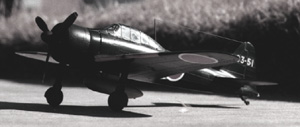
FAQ: Zero Night Fighter

By Rob Graham
In the early days of WWII, the Imperial Japanese navy was very skilled at night warfare, and was arguably the best trained in the world for such situations. Pilots were required to be capable of night fighting, and instead of using RADAR (the IJN did not consider air to air RADAR to be a device of much importance until late in the war), the pilots were injected with a drug that would improve their night vision. Because the Japanese pilots were so skilled and many Japanese naval aircraft were often used for both night and day fighting, it is difficult to find dedicated night fighters except for the J1N1-S (Irving) and P1Y1-S (Frances) night fighter versions of these planes. Zeros were quite rare in this role.
On several occasions, requests for information on the Zero Night Fighter have been asked. Current research shows it did exist, but this elusive aircraft has been one of as much mystery as it has been of misinformation. Current research shows there were actually two different planes, and they are:
A6M2 Night Fighter (paint scheme only)
Overall Dark Green night fighter scheme with no apparent modifications to the airframe or other equipment. See page 19 of Famous Airplanes of the World #56 and page 64 of Zero: Japan's Legendary Fighter by Robert C. Mikesh. See also page 203 of Illustrated Zero Fighter by Shigeru Nohara.
A6M5 Oblique Gun Armed Fighter (hardware conversion, but no night paint scheme)
The name A6M5d-S is a misnomer, since this was actually a name tagged on by historians who were seeking some type of distinction. This was a field modification to various existing A6M5 aircraft (they were generally A6M5s, A6M5as, or A6M5bs), and was not actually conceived as a dedicated night fighter. It carried an added Type 99-2 Model 4 20mm in the fuselage behind the pilot with the barrel protruding through the fuselage skin, and it fired 30º forward and 30º to the left in earlier iterations, later just 30º forward and 10º to the left from the centerline of the fuselage. The final versions fired 30º forward and 10degrees to the left, but were recessed in the rear section of the glazed canopy. See pages 18, 60, page 82, page 126, of Koku Fan 97-10, #96 about the 302 Kokutai for photos of the later versions. See the second profile on page 83 of Famous Airplanes of the World #56 for a drawing.
Hiroyuki Takeuchi posted (Monday, 5 October 1998) a translation of one of his sources:
20mm Oblique Gun Outfitting
"The oblique gun installation to upward and to sideways was terminated because an accident killed a maintenance man who was walking on the wing root, and because it was difficult to aim. The oblique guns on single seaters was very unpopular from the conceptual stage, and caused some protest from pilots and chutai commanders, but was installed anyway at the insistence of the 302-ku commander Y. Ozono who had excessive faith in this weapon. As a result, they were not widely used and were later deleted.
"Ozono's idea was to use the weapon not only against bombers, but also in dog fighting. If mounted to fire up and to the left, his idea was that it would be possible to fire at the enemy fighter before you actually got to his tail during a classic dog fight where two fighters would be going around in a left hand circle.
Maru Mechanic (last paragraph on page 139) has a small blurb, and I translated it. As far as my limited translation capabilities can reveal, it says:
Night Fighter Model
"For night duty air-defense sorties, Model 52 Zeros were equipped with slanted 20mm cannon. To meet the needs of air defense, it was agreed that an immediate revision be made. All subsequent model 52s would be so equipped."
Of the several sources, evidence shows there was a Night fighter A6M2 color scheme, as seen in the 2 pictures of the Tarawa A6M2 wreckage (tail code not known) and the photo of A6M2 #03-51 at Hokkaido in April of 1945. These two planes were in very different locations, but seem to be Nakajima-built Zeros with overall glossy dark green paint and white surrounded Hinomarus in all six locations. Note 03-51's drop tank was light in color, possibly the IJN gray-green, and tail numbers appear to be white. For the Tarawa A6M2, see page 19 of Famous Airplanes of the World #56 and page 64 of Zero: Japan's Legendary Fighter by Robert C. Mikesh; look on page 94 for the A6M5 night fighter. See also page 203 of Illustrated Zero Fighter by Shigeru Nohara. The published source for the photo of 03-51 was in a Japanese periodical.
See Don Thorpe's book on IJNAF colors, Japanese Naval Air Force Camouflage and Markings World War II, page 132 #14, for yellow YoD1104. Likely in yellow. This is pictured with gray undersides, but the drawing refers to the "overall" scheme.
Bibliography:
Famous Airplanes of the World #56, 1996
Zero: Japan's Legendary Fighter by Robert C. Mikesh, Motorbook International, 1994, ISBN 0-87938-915-X
Illustrated Zero Fighter by Shigeru Nohara, Green Arrow Publishing, ISBN 4-7663-3178-8
Maru Mechanic, 1985.12
Japanese Naval Air Force Camouflage and Markings World War II, Don Thorpe, 1977, ISBN 0-8168-6587-6
Koku Fan 97-10, #96
Special acknowledgement to all the researchers, historians, and other unseen and unsung heroes who have brought this information to be published, including (but not limited at all to) Robert Mikesh, Don Thorpe, Shigeru Nohara, Jim Lansdale, the late Martin Caidin, and the many others; and an extra special Texas thanks to Hiroyuki Takeuchi for his help in researching this subject.
© 1999, 2000 Rob Graham